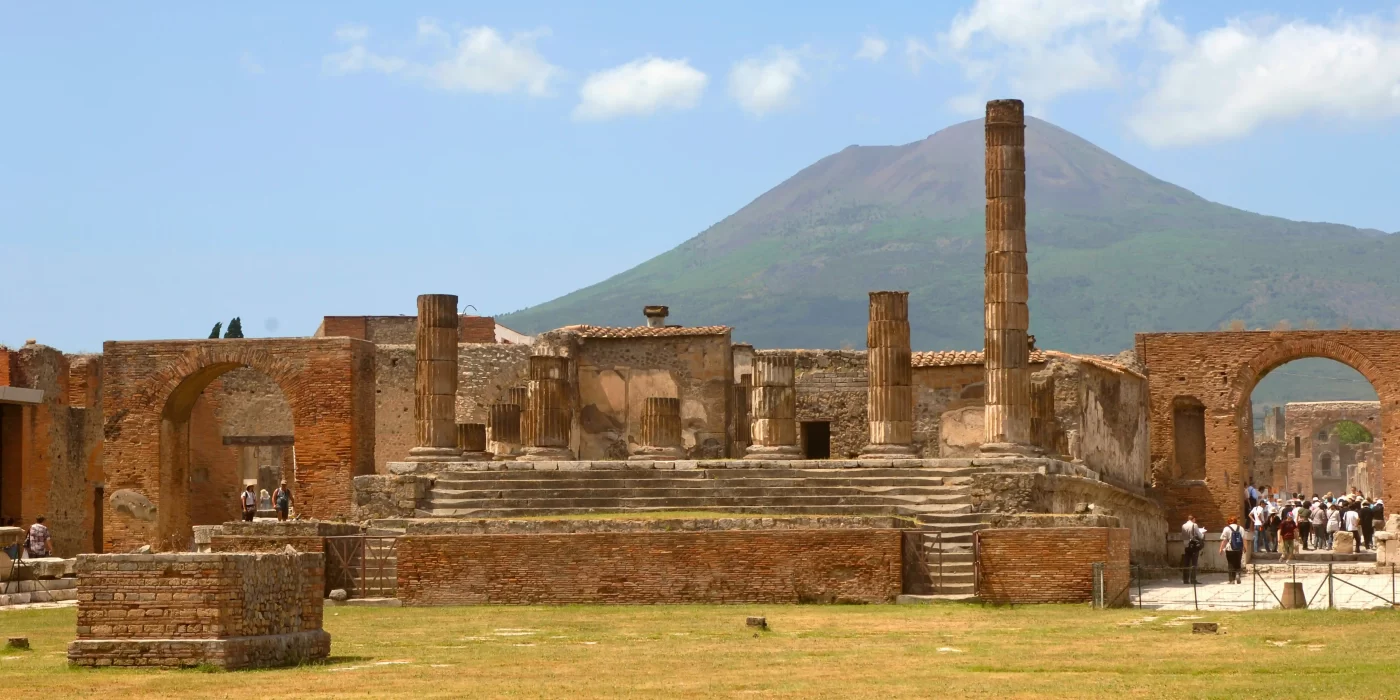New discoveries in Pompeii : the buried town continues to astonish
Among the most visited archaeological sites in the world, the Pompeii ruins recorded over 4 million visitors in 2024. This represents an all-time record for the site, which is a unique observatory on life in the Roman Empire, during the period of the devastating eruption of Vesuvius in 79 AD. The lava rock and ash that submerged the town on the slopes of the volcano, surprising its inhabitants, froze it over the centuries. New discoveries in Pompeii continue to release evidence of that distant past, reviving interest in this site of immortal charm. Of course visiting Pompeii is a once-in-a-lifetime experience, but the continuous stream of findings makes it a place worth visiting even more than once in a lifetime, especially for those passionate about ancient history.
New discoveries in Pompeii: What was found in Pompeii?
But what was found in Pompeii? In January 2025, the ongoing excavation on a residence, uncovered over the last two years, revealed a large private bathhouse. The spa-like complex, complete with hot, warm and cold rooms, is among the largest and most complex discovered so far: a real godsend for ancient history enthusiasts. The magnificent cold plunge pool is bordered by red columns and frescoes of athletes. The bathhouse includes a changing room provided with red walls, a mosaic floor, and stone benches, and has a capacity of thirty people. Its proximity to the banquet hall supports the Roman habit of inviting guests to a bathing session at the thermal baths and subsequently providing a banquet. The find is among the most interesting new discoveries in Pompeii.
Pompeii discoveries reveal details of Roman daily life activities
The rarity of private baths indicates the homeowner’s elevated social standing. The practice of holding opulent banquets in conjunction with relaxing visits to the thermal baths further underscores their place within the city’s elite. These clues suggest that the Roman domus actually served as a stage for its owner, a place halfway between public and private dimensions, in which to secure the electoral consensus of the public or establish a social status. The new discoveries in Pompeii provide further clues to the reconstruction of Roman daily life in all its aspects.
Pompeii discoveries: just like a scene described by Petronio
In a fragment of the Satyricon, a well known Latin literary work attributed to Petronio, the wealthy freedman Trimalchio celebrates his famous dinner, set in a not specified Campanian city of the 1st century AD and therefore culturally not far from the reality of Pompeii before the eruption of 79 AD. Before going to the banquet, the protagonists of the novel, including Trimalchio, go to a balneum (bath). Although not set specifically in Pompeii, the story illustrates the social dynamics in use in the provinces of the Roman Empire and the exaggerated display of luxury, especially by those who, despite having become wealthy, still fail to elevate themselves culturally. This is yet another example of how Pompeii discoveries bring back the smallest details of everyday life in ancient Rome, and also demonstrates the significant lack of change in social dynamics over the centuries.
Pompeii discoveries within the same excavation operation: The Sacrarium
Within the same excavation operation, in 2024, other Pompeii discoveries took place. A room interpretable as a Sacrarium was discovered, connected to the bathhouse, with walls featuring a blue background (rarely used in Pompeii, attributable to the Fourth Style) and decorated with female figures representing the seasons, as well as two allegories, of agriculture and pastoralism. For the urban elite who commissioned these frescoes, the historical-cultural context was one of nostalgia for a lost rural world, idealized and cherished as a distant, unrecoverable past.
Evidence suggests that the room served both as a repository for sacred objects and as a site for ritual activities. Archaeological work has led to fifteen transport amphorae, a bronze set of two jugs and two oil lamps, and various building materials, including oyster shells concentrated at the entrance. These shells were likely processed and reused in the construction or renovation of the room, mixed into the plaster and mortar.
New Discoveries in Pompeii: The Black Banquet Hall
A few months before the discovery of the Sacrarium, a magnificent banquet hall was unearthed, provided with black walls adorned with scenes from the Trojan War. Now fully revealed, the room’s grandeur is striking. It evokes a sense of refined living, a place for social gatherings, banquets, and lively discussions. The room’s sheer size, along with its Third Style frescoes and mosaics, the artistry of the paintings, and the carefully chosen mythological themes, all speak to the high status of its owners.
The new discoveries in Pompeii are related to the huge Pompeii excavation of Regius IX
All these new discoveries in Pompeii are related to the same area. In fact, recent archaeological work is focused on Regius IX, a sector of the Campanian site that was previously inaccessible. Divided into nine districts, this location holds considerable potential for new insights into the past. Among the other recent finds in Regius IX, other two domus Originally constructed during the Samnite period, these structures were repurposed in the 1st century AD as production facilities. One such facility, a fullonica (essentially a Roman laundry), occupied the atrium of the house at number 2. It featured work areas and vats for laundering and dyeing garments. The other was a bakery, complete with an oven, milling
areas, and spaces for preparing foodstuffs for urban distribution.
Pompeii discoveries: How much of Pompeii was excavated?
A common question by tourists from all over the world is: How much of Pompeii was excavated? The very first attempts to excavate the ancient Pompeii date back to the initiative of Emperor Alexander Severus, but it was only with the order of Charles of Bourbon in 1738 that the actual excavations began. Since then, it is estimated that about 49 hectares of the 66-hectare area have been excavated. This means that a third of the ancient city of Pompeii still lies beneath the lava stone. Since 2012, the Great Pompeii Project, born from an action of the Italian Government, aims to preserve the remains already surfaced, consolidating the walls and restoring the decorated surfaces. The interventions are focused on protection from bad weather, hydrogeological risk and looting. In short, Pompeii discoveries are the result of a targeted action, in which the race against the ravages of time reduces human initiative and puts a brake on curiosity. For now.

